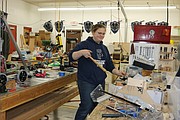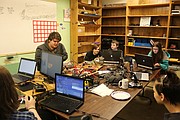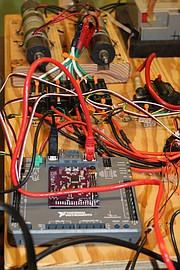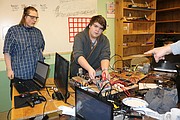Solving problems, building robots
BONNERS FERRY — Twelve years ago, in our small, rural community that has a heavy emphasis on logging and agriculture, a dream was formed to bring robotics to the students of Boundary County. Ed Katz was a high school science teacher and saw a niche to be filled.
“I saw a need to make academics — science — have the level of interest and cultural acceptance as other extracurricular activities at the high school,” said Katz.
Katz heard about a robotics program called FIRST® (For Inspiration and Recognition of Science and Technology), with a reputation of encouraging students to pursue further education and careers in STEM-related fields. With competitions, as well as the ability to work in conjunction with other teams all over the world, it seemed the perfect fit. Katz decided to pursue the idea, and the dream was born.
“I saw a NASA grant available to start it and it looked like it was a fair amount of money,” said Katz. “I thought I would try it for a year and see what it was like. It hit all the things I was looking for.”
FIRST Team 2130 Alpha+ was formed — and from humble beginnings, the Bonners Ferry team has grown to be a top contender, competing at World Championships five times, as well as receiving many other awards, such as the Rookie Inspiration Award, Engineering Inspiration Award, and Innovation in Control Award.
“We are noted as one of the better teams in this program, which is amazing, and it comes from a lot of hard work,” explained Katz. “It’s tough … it is not a simple thing.”
Next up for the Alpha+ team will be the Idaho Regional in Nampa, from March 27-31, where more than 50 teams are expected to compete.
The students have been hard at work, spending every night after school, as well as Fridays and Saturdays, getting ready for the competition. In the process, they are combining old world skills, like welding and fabrication, with new world skills, like programming and CAD.
“We are trying to present those skills, so they have a modern interface of skills, and understand how the two go together, and then solve problems,” said Katz. “What you need in education now, is that need to be able to problem solve.”
From fabrication to programming, the team members work with a multitude of mentors to design, fabricate, and program their robot to do a myriad of tasks presented to them as part of the competition. They learn to ask themselves the correct questions, and in doing so, learn to problem solve.
“In our culture they are spoon fed in school. They sit in classrooms and regurgitate answers. They don’t necessarily work at hard problems,” said Katz. “These are very difficult problems under hard pressure. We have to build this thing in six weeks.”
This year’s competition is taking the team to the outer limits of the universe in Destination: Deep Space, which is presented by The Boeing Company. In this competition, the scenario is that of deep space travelers on Planet Primus that are collecting samples. Two competing alliances will combat unpredictable terrain and sandstorms, while placing hatch panels on their rockets and cargoship, then loading valuable cargo for transport off the planet, before returning to the safety of their habitat
Each alliance, which is a combination of two teams, has two rockets, one cargoship, and a habitat which is where the robots begin and end the competition. For the first 15 seconds, vision will be blocked by a mock waning sandstorm, requiring the robots to be controlled by either using autonomous code, or manually with a vision system on the robot. The alliance earns points by loading as much cargo as they can before liftoff, which is two minutes and 30 seconds.
“So there is a spirit of cooperation, then there is the hardcore competition at the end,” explained Katz. “Sometimes a really good championship team will go and fix a rookie team to get them working right.”
The build time is now over for the team and they look forward to the thrill of competition. The entire process, from conception to completion, is a learning process for the team members, and the lessons learned has put some of the former team members well ahead in college.
“Some of our kids who move on are already two years into college stuff, if not more,” said Katz.
Junior Clinten Hopkins has been involved with robotics for six years, first in middle school and now in high school.
“I hopefully want to go into software development later on,” said Hopkins.
Hopkins has taken it upon himself to mentor other teammates.
“He is teaching them before, so they have the skills to be able to jump into it when it starts,” said Katz. “So you have this peer to peer tutoring, which is what I had hoped would happen. It took a lot of years to establish that culture.”
Some of the life experiences that are gained through the program are further reaching than just the robotics skills. Sophomore Emmet Melior qualified for, and attended, the world competition last year.
“It was really scary at first because first it was at Boise, then Calgary, and then we went to Houston,” explained Melior. “I had never been farther than Spokane, and so all of a sudden, in the span of two months, I went from Boise to crossing an international border — which I had never done. Then we had to fly to Houston and I had never been on a plane.”
Sophomore Regina Claphan is in her third year of robotics and shows no signs of slowing down.
“It is really interesting and you get to learn a lot of new skills,” she said. “Competition is an amazing experience.”
Working alongside the students is a wide variety of mentors. Many of them started because they had a child that was part of the team, and then stayed on after their child graduated. Many of them referred that process as being sucked into the “vortex.”
John Kaessinger, a Signal Inspector for BNSF Railroad, joined the team in their 2007 rookie year with his son, Jacob. He is a build and electrical team mentor and pit foreman
“My son, and Ed, and my wife actually were the original people who started this. Because my son was involved in it, I got sucked into the vortex, as we call it,” said Kaessinger with a chuckle. “I see the incredible value to the community and to the kids, providing really hands on STEM experience. They learn by immersion. It is really cool.”
Adam Krezman joined the team as a design and build mentor after finding out about the team through his son, Conner, who is now a mechanical engineering major.
“It is awesome,” said Krezman. “It is the best sport that I have ever seen. I love every part of it. I love helping the kids, I love watching them build, I love showing them how to lathe, I love everything.”
The mentors are not just standing back and instructing the team members, they are working hands on with them. The problems presented with the build challenge all the members.
“With all the mentors we have here, it is still very difficult to solve these things,” said Katz. “The get the opportunity to try out some real world stuff. My goal isn’t to make programmers or engineers, it is to give kids a chance to learn how to problem solve... which you can apply to anything.”
The team faces significant competition around the world, even going up against teams that are coached by NASA with full engineering shops.
“We can do it here,” insisted Katz. “We are even in talent — what we miss sometimes in rural areas, is opportunity. The talent is here, it is whether we are going to give the opportunity to the kids. That is my ambition.”
Katz explained that the equipment they use is sophisticated.
“It isn’t like ten year old technology. It is cutting edge,” he said. “If we are doing virtual reality with goggles, then we need to buy goggles, so they get to play with it.”
There is a whole team within FIRST Team 2130 Alpha+ that is dedicated entirely to business, which includes funding. They depend on donations for equipment, supplies, and travel to competitions. The mentors are all volunteers, so there is no funding needed for them, however, the travel expenses are similar to the costs of other teams, like sports.
“People might be surprised what it costs to run a team,” said Katz. “A bus to southern Idaho is $4000. If you send a basketball team to a championship, it gets covered. We pay four grand. To stay at the hotel down there is going to be another $3000-4000.”
“The community has been spectacularly generous,” Katz said about donations received from businesses and individuals.
With the robot built, the team now awaits their chance to compete, test their skills against others, while also learning from the other teams, and passing on their knowledge as well. What started as a dream is now a reality, as our small town robotics team makes a name for itself, year after year.
“I saw what was possible — and I could see it in the kids — that they could do it. It is just a matter of putting stuff together,” said Katz.
For more information: http://bfhsrobotics.com













